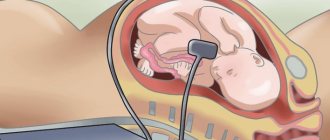Hypertension is a common companion of women during pregnancy, when metabolic processes in the body intensify and intra-abdominal pressure increases. High blood pressure in pregnant women threatens to develop serious consequences, including premature birth, miscarriage, and even death. Therefore, it is important to have an idea of which antihypertensive drugs are most effective during pregnancy, whether concomitant treatment is necessary, and many other features of hypertension in women during this wonderful and crucial period.
Therapists at the Yusupov Hospital will help you choose a drug for the treatment of hypertension that is both highly effective and has minimal side effects.
Causes of high blood pressure during pregnancy
Arterial hypertension syndrome in women during pregnancy can be triggered by several factors. Blood pressure in pregnant women increases due to the following changes:
- the location of the heart changes;
- hormonal changes occur - the level of progesterone and estrogen in the blood increases;
- placental blood circulation increases;
- body weight increases;
- the mobility of the diaphragm is limited.
The development of all hemodynamic changes during pregnancy leads to a complex of problems that trigger arterial hypertension syndrome.
Decreased tonometer readings
The 1st trimester during pregnancy is often manifested by a decrease in blood pressure. Many women perceive this symptom as an indispensable attribute of pregnancy and do not consult a doctor, even if the tonometer shows numbers below 90/60. If you feel well and there are no dangerous symptoms, even such marks can be perceived as normal.
But a significant decrease in pressure may be accompanied by the following symptoms:
- dizziness;
- nausea with urge to vomit;
- dyspnea;
- throbbing headaches in the temples and back of the head;
- the appearance of tinnitus;
- development of drowsiness and apathy;
- high pulse;
- cold sweat.
There may be several reasons for this condition. The main one is excessive production of progesterone, but low blood pressure is often provoked by stress, lack of sleep, chronic fatigue, and insufficient exposure to fresh air. To normalize the tonometer readings, adequate rest, proper nutrition containing vitamins and nutrients, and limiting stress are sufficient.
Another cause of hypotension is considered to be dehydration; this problem worries women more often in the summer. Reduced tonometer readings are regularly observed in women with low body weight. As a rule, the 2nd trimester is manifested by stabilization of blood pressure (blood pressure) and normalization of the expectant mother’s well-being.
Treatment and hospitalization of pregnant women with hypertension
In order to confirm the diagnosis and select adequate treatment, pregnant women with hypertension syndrome must be hospitalized three times. Antihypertensive drugs during pregnancy are prescribed strictly by the attending physician, who takes into account the duration of pregnancy and possible complications of intrauterine development of the fetus.
- the first hospitalization is carried out in the early stages (up to 12 weeks) - for the purpose of diagnosing hypertension;
- a second hospitalization is planned in the period from 26 to 30 weeks - in order to change therapy;
- The third hospitalization is prescribed a couple of weeks before the birth - to prepare for it.
When gestosis develops against the background of arterial hypertension, the woman requires immediate hospitalization, regardless of how far along the pregnancy she is at that moment.
Arterial hypertension in pregnant women requires constant drug support. Women are prescribed medications, and not only antihypertensives. During pregnancy complicated by high blood pressure, it is recommended to take sedatives, calcium antagonists, beta-blockers, alpha-blockers. In addition, symptomatic therapy is carried out.
In addition to drug therapy, a woman is recommended to follow a special regimen and diet throughout pregnancy.
There are a number of recommendations for pregnant women suffering from arterial hypertension:
- Observing the correct sleep and rest schedule helps to normalize the emotional state - you need to sleep at least 9 hours a day;
- you need to exclude any physical activity;
- A pregnant woman with arterial hypertension syndrome needs to constantly measure her blood pressure.
The nutrition of a pregnant woman, even despite toxicosis, should be complete and nutritious, with a sufficient amount of vitamins, microelements, proteins and antioxidants. It is recommended to include seafood and other foods containing polyunsaturated acids in your diet.
Antihypertensive therapy for diabetes mellitus
Diabetes mellitus is a chronic disease, the development of which is associated with an absolute or relative deficiency of the hormone insulin. Lack of insulin or lack of sensitivity to it leads to an increase in blood glucose levels. This condition has a negative impact on all systems and organs of the human body, including the cardiovascular system.
Almost all patients suffering from diabetes complain of high blood pressure, which can be reduced with great difficulty without the help of a doctor.
Hypertension and diabetes mellitus
Hypertension in patients with diabetes is an integral and very dangerous component, which can several times increase the risk of developing the following diseases:
- 3-5 times - heart attack;
- 3-4 times - stroke:
- 10-20 times - blindness;
- 20-25 times – renal failure;
- 20 times - gangrene, requiring limb amputation.
If blood pressure readings exceed 140/90, there is no need to hesitate to contact a specialist, since hypertension that occurs against the background of diabetes mellitus can lead to the development of irreversible consequences, often incompatible with life.
Hypertension in type 1 diabetes mellitus
The main and most dangerous cause of arterial hypertension in type 1 diabetes mellitus is the presence of diabetic nephropathy in patients with this disease. The development of this complication is observed in almost 40% of people suffering from type 1 diabetes. Increased blood pressure is directly related to the amount of protein excreted in the urine.
Hypertension due to renal failure also develops due to poor excretion of sodium in the urine. As sodium increases in the blood, fluid accumulates to dilute it. Due to the increase in circulating blood volume, blood pressure increases. This process may also be associated with an increase in glucose concentration, which occurs in diabetes mellitus. As a result, to reduce blood density, the body produces even more fluid and the volume of circulating blood further increases for this reason.
Hypertension in type 2 diabetes mellitus
One of the factors that provokes the development of type 2 diabetes mellitus is insulin resistance, i.e. decreased sensitivity of tissues to the action of insulin.
To compensate for insulin resistance, excessive amounts of insulin circulate in the blood, which itself causes an increase in blood pressure. Over time, a narrowing of the lumen of blood vessels occurs, caused by atherosclerosis, which also contributes to the occurrence of hypertension. In parallel, patients experience the development of abdominal obesity, and, as is known, it is from adipose tissue that substances that increase blood pressure are released into the blood.
Hypertension in diabetes: features
In patients with diabetes mellitus, there is a disturbance in the natural daily rhythm of blood pressure fluctuations. In a healthy person, blood pressure levels in the morning and at night are usually 10-20% lower than in the daytime. In patients with diabetes, there is no decrease in blood pressure at night. Moreover, their nighttime pressure readings may be even higher than their daytime ones. According to experts, this phenomenon is caused by diabetic neuropathy. An increased concentration of sugar in the blood leads to damage to the autonomic nervous system, which is responsible for regulating the body's vital functions. There is a deterioration in the ability of blood vessels to regulate their tone - narrowing and relaxing depending on the load.
Antihypertensive drugs for diabetes mellitus
To date, eight groups of antihypertensive drugs are known, of which five are considered primary, and three are considered additional. Antihypertensive therapy for diabetes mellitus involves taking the following medications:
- diuretics;
- calcium channel blockers;
- beta blockers;
- centrally acting drugs;
- ACE inhibitors;
- angiotensin II receptor blockers;
- alpha-blockers;
- renin inhibitor (racillosis).
Medicines that make up additional groups are prescribed, most often, as components of combination treatment.
Antihypertensive drugs during pregnancy
Drugs that have an antihypertensive effect during pregnancy must be used very carefully, strictly observing the dosage and duration of the course prescribed by the attending physician, in order to avoid negative effects on the fetus caused by insufficient blood supply to the placenta due to a decrease in blood pressure.
Alpha and beta blockers during pregnancy
Taking beta-blockers is prescribed to prevent premature termination of pregnancy.
There are good reasons to take these drugs:
- beta blockers quickly and effectively reduce blood pressure;
- the risk of side effects when taking drugs of this group for pregnant women is minimal;
- simultaneous use of alpha and beta blockers increases the effectiveness of therapy.
Taking these drugs is undesirable if blood pressure is unstable, due to the fact that they contribute to a sharp decrease in blood pressure.
Calcium antagonists during pregnancy
In the treatment of arterial hypertension syndrome, pregnant women are prescribed drugs - potassium antagonists, which help improve microcirculation and permeability of the heart muscle. These medications can be used no earlier than in the second trimester of pregnancy.
Calcium antagonists have a number of advantages: they minimize the likelihood of having children with insufficient body weight, are absolutely non-toxic to the child, and also reduce the frequency of preeclampsia in early pregnancy.
However, this group of antihypertensive drugs also has a number of disadvantages: blood pressure decreases too quickly, which threatens circulatory disorders in the placenta, the appearance of swelling of the extremities, allergic reactions and dyspeptic disorders.
Diuretics during pregnancy
Diuretic drugs (diuretics) in the treatment of hypertension in pregnant women help reduce blood pressure and eliminate edema. However, like all drugs, diuretics also have side effects associated with a deterioration in the flow of blood into the placenta due to a decrease in fluid volume, additionally caused by early and late gestosis. In addition, while taking diuretics, the electrolyte balance may be disrupted and the concentration of uric acid may increase, which has a negative effect on the condition of the placenta during gestosis.
Persisting arterial hypertension after childbirth as a component of metabolic syndrome
Search for effective correction methods
Metabolic syndrome is a combination of a number of factors that greatly increases the risk of cardiovascular disease. According to various authors, the prevalence of metabolic syndrome continues to increase and currently ranges from 5 to 20%. The history of the emergence of the concept of “metabolic syndrome” begins in the middle of the 20th century, when in 1947
J. Vague described two types of fat deposition - android and gynoid and suggested that android obesity is more often combined with diabetes mellitus, coronary heart disease and gout. In 1988
G. Reaven identified a symptom complex that included hyperinsulinemia, impaired glucose tolerance, elevated triglycerides, low high-density lipoprotein (HDL) cholesterol and arterial hypertension (HTN), calling it “syndrome X.” At the same time, it was suggested that the disorders united within the framework of the syndrome are related by a single origin - insulin resistance and compensatory hyperinsulinemia. In 1989, J. Kaplan, describing the “deadly quartet,” identified abdominal obesity, along with impaired glucose tolerance, hypertension and hypertriglyceridemia, as an essential component of the syndrome.
Today, the generally accepted term “metabolic syndrome” is widely used throughout the world.
In 2004, the All-Russian Scientific Society of Cardiology (RSC) adopted criteria for diagnosing metabolic syndrome, which correspond to the criteria of the US National Cholesterol Education Program (2001). According to these criteria, the basis for a diagnosis of metabolic syndrome is the presence of three or more of the following five components:
- abdominal obesity - waist circumference (WC) > 102/88 cm (men/women);
- high triglycerides: > 150 mg/dL (1.69 mmol/L);
- low HDL cholesterol: < 39/50 mg/dL (men/women) (1.04/1.29 mmol/L);
- AH > 130 and/or 85 mm Hg. Art.;
- plasma glucose level 110 mg/dL (6.1 mmol/L).
Somewhat different criteria for diagnosing metabolic syndrome have been adopted by WHO (1988) and the International Diabetes Federation (2005).
International Diabetes Federation criteria:
- abdominal obesity and at least two of the following criteria:
- fasting hyperglycemia;
- AG;
- increased triglyceride levels;
- lowering HDL cholesterol.
WHO criteria:
- insulin resistance or hyperglycemia and at least two of the following criteria:
- abdominal obesity;
- AG;
- increased triglyceride levels;
- lowering HDL cholesterol;
- microalbuminuria.
Today, the problem of metabolic syndrome is extremely relevant throughout the world. Despite the large amount of scientific research, metabolic syndrome requires further research to understand who, when and how to treat (R. Kahn et al., 2005).
According to the decision of the International Diabetes Federation Consensus Group, the most relevant aspects of the metabolic syndrome that require further study are:
- etiology of metabolic syndrome;
- the relationship between blood pressure (BP) and other components of the metabolic syndrome;
- the relationship of various combinations of metabolic syndrome components with cardiovascular disease outcomes;
- the impact of correction of metabolic syndrome components on the risk of developing cardiovascular diseases;
- searching for ways to improve the efficiency of identifying high-risk patients with metabolic syndrome in different populations.
Numerous scientific studies in recent years show that the moment of “launch” of metabolic syndrome in women can be the period of pregnancy.
The components of metabolic syndrome during pregnancy have their own distinctive features. Hypertension during pregnancy is closely related to insulin resistance, but it has not yet been definitively determined in which type of hypertension insulin resistance is most pronounced. In a study by A. Caruso and S. Ferrazzani (1999), a clamp test showed that insulin resistance is most pronounced in women with gestational hypertension. And in the groups of patients with gestosis and physiological pregnancy, the results were similar. Another study (R. Kaaje, H. Laivuori, 1999) showed that insulin resistance is most pronounced in preeclampsia.
The question arises, what comes first during pregnancy - insulin resistance or hypertension? It is known that hyperinsulinemia increases the activity of the sympathoadrenal system, leads to an increase in the reabsorption of sodium and water in the proximal tubules of the kidneys, promotes the proliferation of vascular smooth muscle cells, blocks the activity of Na-K-ATPase and Ca-Mg-ATPase, increasing the intracellular content of Na+ and Ca++, increasing the sensitivity of blood vessels to vasoconstrictors. All these factors lead to the development of hypertension.
In addition, hyperinsulinemia is detected early in pregnancy, before the development of gestational hypertension or preeclampsia (M. Serer, CD Naylor, 1995; JR Sowers, RJ Sokol, 1996; GM Joffe, JR Esterlitz, 1998; CG Solomon, JS Carroll, 1999; KE Innes, JH Wimsatt, 2001). Obesity and physical inactivity predispose to the development of hypertension during pregnancy. A high body mass index (BMI) before or at the beginning of pregnancy is associated with an increased risk of developing preeclampsia and gestational hypertension (CG Solomon, SW Graves, 1994; KE Innes, JH Wimsatt, 2001; R. Thadhani, MJ Stampfer, 1999; N. Sattar , P. Clark, 2001; A. Saftlas et al., 2000). Increased physical activity in the first 20 weeks of pregnancy, on the contrary, is associated with a decrease in this risk (S. Marcoux et al., 1989).
Components of the metabolic syndrome play an important role in the development of pregnancy complications, which, in turn, are likely to influence the future prognosis of cardiovascular diseases in both mother and child. Data have accumulated to suggest that women with a history of pregnancy complications (preeclampsia, gestational diabetes, hypertension, etc.) are at risk for further development of cardiovascular pathology and diabetes mellitus, i.e. pregnancy can be considered a stress test, predicting a woman’s health in later life (D. Williams, 2003).
A number of foreign studies have revealed a significant increase in the risk of developing hypertension in women with a history of preeclampsia. Jonsdottir et al analyzed the causes of death of 374 women who had hypertensive complications during pregnancy and found that the mortality rate from cardiovascular diseases in these women was significantly (1.4 times) higher than in the general population. In addition, it was found that mortality from cardiovascular diseases in women with a history of eclampsia and preeclampsia is 1.9 times higher compared to women who had increased blood pressure without proteinuria during pregnancy. VA Rodie et al (2004) found that pregnancy complications, especially preeclampsia and chronic intrauterine fetal malnutrition, increase the subsequent risk of developing cardiovascular disorders in women.
Pouta A. et al (2004) showed that women with preeclampsia have an increased risk of developing insulin resistance after childbirth.
A prospective observation of 3799 nulliparous women from 1989 to 1997 with the formation of 168 case-control pairs and observation during pregnancy and for 7–8 years after childbirth revealed that in the group with hypertension during pregnancy the risk of metabolic syndrome was 3–3. 5 times higher than in the group without hypertension (JC Forest, J. Girouard, 2005).
All of the above indicates that hypertension syndrome during pregnancy can be considered an independent risk factor for cardiovascular diseases and, possibly, a factor in the formation of metabolic disorders. Accordingly, women with hypertension syndrome during pregnancy require close medical supervision not only during pregnancy, but also after childbirth. Unfortunately, very often after childbirth, women, due to their busyness, pay little attention to their health and do not consult a doctor. However, it has now been proven that the earlier treatment for hypertension that persists after childbirth is started, the more favorable the prognosis. Therefore, it is necessary to actively monitor the state of the cardiovascular system after childbirth in women with hypertension syndrome during pregnancy and, if hypertension persists, provide appropriate treatment.
How to treat hypertension that persists after childbirth as part of the metabolic syndrome? When choosing optimal therapy, the effect of the drug on the main components of the metabolic syndrome should be taken into account. Medicines used to treat hypertension can be divided into three groups:
- having a metabolically positive effect (ACE inhibitors, selective α1-blockers, angiotensin II receptor antagonists, imidazoline receptor agonists);
- having a metabolically neutral effect (long-acting calcium antagonists, highly selective β-blockers, thiazide-like diuretics);
- having a metabolically negative effect (non-selective β-blockers, thiazide diuretics).
Of course, when choosing the optimal drug for the correction of hypertension that persists after childbirth, preference should be given to drugs that have a metabolically positive effect.
ACE inhibitors have a proven hypotensive effect and are characterized by a pronounced positive effect on the components of the metabolic syndrome. Metabolic effects of ACE inhibitors:
- decreased insulin resistance and improved glucose metabolism, which is associated with increased formation of bradykinin and improved microcirculation;
- a positive effect on lipid metabolism, manifested by a moderate tendency to reduce the level of cholesterol, triglycerides, and a decrease in the atherogenicity coefficient;
- can contribute to the metabolic provision (through the influence on lactate dehydrogenase and glucose-6-phosphate dehydrogenase) of oxygen transport, activating the processes of synthesis of high-energy compounds in erythrocytes;
- increase urate excretion by the kidneys.
Angiotensin II (AT II) receptor blockers modulate the functioning of the renin-angiotensin-aldosterone system (RAAS) through interaction with angiotensin receptors. Recent studies of endothelial dysfunction in hypertension suggest that the cardiovascular effects of ATII receptor blockers may also be associated with endothelial modulation and effects on nitric oxide production. Specific blockade of AT II receptors allows for a pronounced antihypertensive and organoprotective effect.
Clinical studies show that all angiotensin receptor blockers have a high antihypertensive and pronounced organoprotective effect and are well tolerated. However, the main limitation to the widespread use of drugs in this group is their relatively higher cost compared to ACE inhibitors.
Imidazoline receptor agonists are centrally acting antihypertensive drugs. Differences in the therapeutic and hemodynamic effect of centrally acting drugs are due to unequal affinities for different types of receptors. The first-generation centrally acting drug clonidine has an affinity for two types of receptors: central α-adrenergic receptors and imidazoline receptors. It is assumed that its hypotensive effect is largely due to stimulation of imidazoline receptors, while the main side effects are mediated by cortical α1-adrenergic receptors.
The imidazoline receptor agonists rilmenidine and moxonidine are highly selective for I1 receptors. Their affinity for I1 receptors is more than 100 times greater than their affinity for α2 adrenergic receptors. Both drugs are characterized by a pronounced hypotensive effect, sometimes accompanied by a slight sedative effect. The hypotensive effect of imidazoline receptor agonists and the resulting decrease in peripheral vascular resistance are associated with their pronounced peripheral sympatholytic activity. In this case, stimulation of I1 receptors causes only a slight decrease in heart rate (HR). Central I1 receptors of the hypothalamic region are involved in the regulation of blood glucose levels, as shown in an experiment with the selective I1 receptor agonist agmatine, which causes a decrease in blood glucose levels. Moxonidine has a similar effect. In addition, it is assumed that imidazoline receptors are localized in the pancreas and their activation leads to increased insulin secretion. Experimental studies have shown that the use of moxonidine in Zucker rats (obesity model) caused a decrease in the level of hypothalamic neuropeptide Y, which may be one of the mechanisms explaining the decrease in body weight during therapy with this drug. However, the use of drugs in this group is limited due to the presence of side effects associated with their central action (sedation, influence on the ability to drive vehicles and perform work that requires precise coordination of movements), and the high cost of all representatives of this group.
Selective α-blockers block the action of catecholamines on α-adrenergic receptors, which leads to vasodilation and a decrease in blood pressure. Despite the positive metabolic effects, drugs in this group are rarely used as monotherapy. Apparently this is due to their side effects. Preference for drugs in this group as monotherapy should be given to patients with high total peripheral resistance, dyslipidemia, diabetes mellitus, and prostate hypertrophy.
Thus, according to the literature, of all antihypertensive drugs that have a metabolically positive effect, for women with hypertension that persists after childbirth after breastfeeding, the most promising group is ACE inhibitors due to their proven effectiveness, high degree of safety and relatively low cost (which important due to the need for long-term treatment).
Today in Russia the group of ACE inhibitors is represented by a wide range of drugs. The main ones are presented in the table.
All of these drugs can be used to treat hypertension in women with persistent hypertension after childbirth (after stopping breastfeeding). The choice of a specific drug within a group must be made taking into account its current availability and cost. The duration of treatment is determined individually and depends on the dynamics of blood pressure; most often, long-term treatment is necessary.
Thus, based on the above, the following conclusions can be drawn.
- Pregnancy with hypertension and metabolic disorders is a risk factor for subsequent cardiovascular diseases.
- The information available to date is insufficient to fully understand the extent of the impact of metabolic syndrome that begins during pregnancy on long-term prognosis.
- It is necessary to focus the attention of doctors and patients on the importance of the earliest correction of hemodynamic and metabolic disorders during pregnancy and after childbirth.
A. Yu. Galyautdinova , Candidate of Medical Sciences O. N. Tkacheva , Doctor of Medical Sciences, Professor N. S. Samsonenko, K. Yu. Guseva, R. M. Kotenko MGMSU, Moscow
Complications of arterial hypertension syndrome in pregnant women
The main danger of arterial hypertension syndrome during pregnancy is a hypertensive crisis. In addition, women are also at risk of other conditions that are dangerous to their health:
- plaques form on the walls of blood vessels, which leads to a significant disruption of the already impaired blood circulation and the supply of necessary substances to the placenta;
- High blood pressure can lead to myocardial infarction, resulting in the death of the child. This occurs due to narrowing of the coronary arteries and insufficient blood flow to the heart;
- arterial hypertension can cause pathological processes in the kidneys, and the development of renal failure may occur due to impaired blood circulation in the kidneys;
- due to impaired blood circulation, central nervous system pathologies may occur: possible development of stroke, chronic failure of brain circulation;
- In addition, pregnant women with arterial hypertension often experience the development of endocrine diseases, visual impairment, metabolic syndrome and many other serious complications.
If a hypertensive crisis occurs, a woman requires immediate treatment.
Hypotensive syndrome
Hypotensive syndrome is a whole complex of symptoms that reflects a persistent decrease in intracranial pressure in women. It occurs only in pregnant women aged 25 to 29 years. This syndrome significantly reduces the quality of life of the expectant mother and requires qualified medical care.
Make an appointment
Causes
The causes of this pathology are the following factors:
- severe dehydration after undergoing drug therapy;
- head injuries;
- leakage of cerebrospinal fluid due to a violation of the integrity of the skull bones or brain tissue;
- a decrease in blood pressure, leading to a decrease in intracranial pressure.
Every pregnant woman should be doubly attentive to her health, since she is also responsible for the life of the child. Any changes in health should be a reason to consult a doctor. Doctors at the Yusupov Hospital are ready to answer all their patients’ questions at any time, either in person or by phone.
Symptoms of hypotensive syndrome in pregnant women are:
- severe constricting sudden headaches;
- increased headaches when raising the head or in a sitting position;
- reduction in the intensity of headaches when lowering the head;
- prostration;
- feeling drowsy;
- irritability;
- attacks of nausea and vomiting.
Of course, many of the above symptoms occur in pregnant women and are a consequence of changes in the functioning of all organs and systems during the period of bearing a baby. They may have nothing to do with hypotensive syndrome.
But in any case, if the expectant mother’s health worsens, she must inform the doctor about it. Caution and attentiveness to your health will help you avoid the development of complications, identify hypotensive syndrome and undergo an effective course of therapy.
Diagnostics
If symptoms of the disease appear during pregnancy, it is necessary to undergo examinations by a gynecologist, neurologist and neurosurgeon. Doctors conduct examinations, analyze all the patient’s complaints and make a preliminary diagnosis. To confirm or refute it, the pregnant woman is prescribed a number of diagnostic measures, namely:
- general and biochemical blood test;
- general urine analysis;
- X-ray of the skull;
- spinal tap;
- MRI of the brain.
At the Yusupov Hospital, all diagnostic procedures are carried out using modern medical equipment, which allows you to obtain accurate data and promptly begin treatment.











